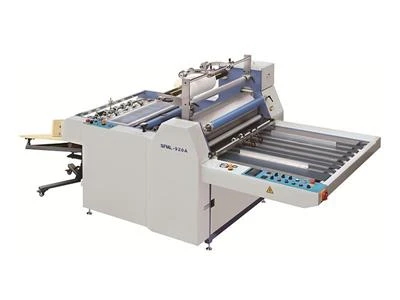Film Laminating Machine

產品說明
Film Laminating Machine
In our life, we'll look at some of the more common types of post press equipment, lamination pouches and accessories available from CHN suppliers. EX.EXPORT will help you decide what to look for in a film laminating machine, and choose which sorts might be the most useful across a range of particular applications, environments and workloads.
SADF-540 Automatic Film Laminator
SF-720C 920C 1100C Semi-Auto Laminating Machine
SFML720A 920A Semi-Auto Laminating Machine
SW-560 Fully Automatic Laminator
SW-820 Automatic Thermal Film Laminating Machine
SWAFM-1050 Fully Automatic Laminator
YDFM-720A 920A Manual Glueless Laminating Machine
YFMA-800 Automatic Film Laminating Machine
How to Maintain a Film Laminating Machine?
A replacing laminator film is a versatile piece of equipment that can be used in a variety of settings, from schools and offices to print shops and production facilities. While it is a durable and reliable machine, it still needs to be properly maintained to ensure optimal performance.
Here are some tips on how to keep your film laminating machine in top condition:
Regularly clean the rollers with a lint-free cloth.
Be sure to use the correct type of laminate film for your project.
Store the laminate film in a cool, dry place.
Always use a sharp blade when trimming the laminated sheets.
Calibrate the film laminating machine regularly to ensure proper heat settings.
How does a Film Laminating Machine Work?
Film laminating machines apply a thin film cover to paper documents by using pressure, heat, and their internal roller mechanism. In the most common scenario, the paperwork is fed into the machine one page at a time, sandwiched between loose plastic film sheets or in lamination pouches.
With most modern pouch protective film laminating machines, the pre-coated plastic film cover has a special extruded adhesive on all its inside surfaces. It is heated under pressure from the rollers to bond tightly together across the back and front surfaces, creating a protective cover and sealing around all four edges.
Some high-end hot cold laminators can adjust temperature and feed-through speeds for efficient and effective handling of heavy-duty pouches or larger work pieces. In addition, some may feature sensors to automatically detect and reverse misfeeds.
As they perform their heating and pressing function, the film laminating machine’s rollers tend to lose some of their heat as it’s transferred directly into the cardboard carrier and the document pouch - this is why you’ll often have to wait a short time between documents, to allow the rollers to come back up to optimal temperature once again before feeding your next document in. However, most modern laminating machines heat up very quickly, so there isn’t usually a significant delay required between successive feeds.
Tips for Changing Laminator Film on EX.EXPORT Film Laminating Machine
Changing the laminator film on the film laminating machine can seem daunting, but with a few simple tips, you can make the process quick and hassle-free. Whether you’re using a hot cold laminator or a standard protective film laminating machine, these steps will help ensure a smooth transition.
Turn Off and Unplug: Always turn off and unplug your laminator before starting. This ensures safety and prevents any accidental burns or electrical issues.
Cool Down: If you’re using a hot cold laminator, allow it to cool down completely before handling the film. This prevents any risk of burns.
Remove Old Film: Carefully remove the old laminating film by cutting it away from the rollers. Be gentle to avoid damaging the machine.
Install New Film: Align the new laminating film with the rollers, ensuring it is straight and wrinkle-free. Secure it in place according to the manufacturer’s instructions.
Test Run: Run a test sheet through the film laminating machine to ensure everything is aligned correctly and functioning smoothly.

